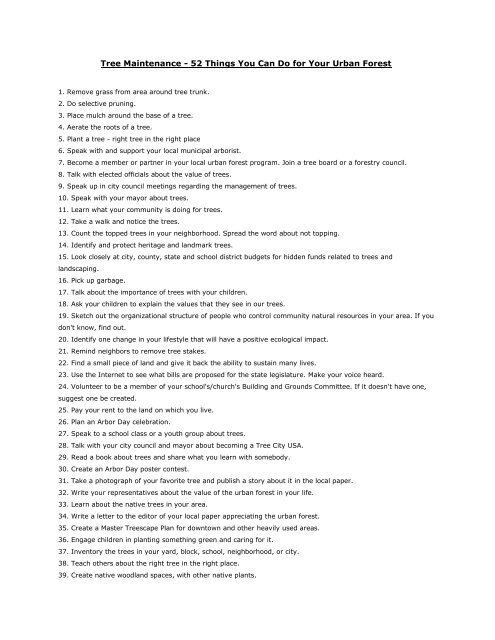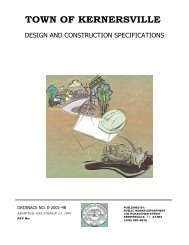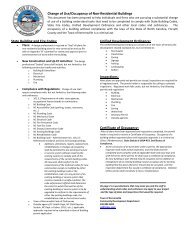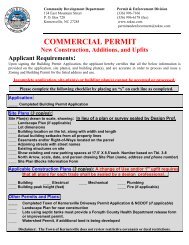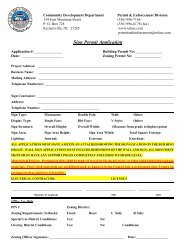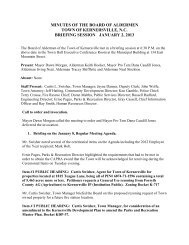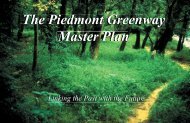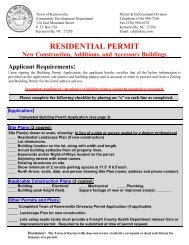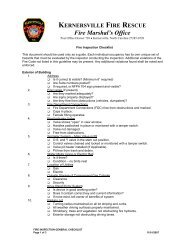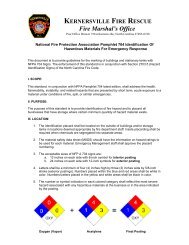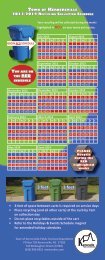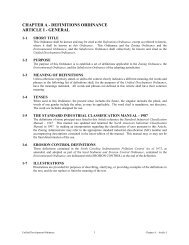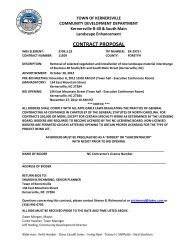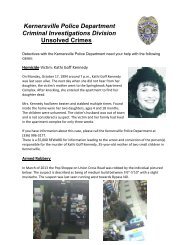Tree Maintenance - 52 Things You Can Do for Your ... - City of Durham
Tree Maintenance - 52 Things You Can Do for Your ... - City of Durham
Tree Maintenance - 52 Things You Can Do for Your ... - City of Durham
Create successful ePaper yourself
Turn your PDF publications into a flip-book with our unique Google optimized e-Paper software.
<strong>Tree</strong> <strong>Maintenance</strong> - <strong>52</strong> <strong>Things</strong> <strong>You</strong> <strong>Can</strong> <strong>Do</strong> <strong>for</strong> <strong>You</strong>r Urban Forest<br />
1. Remove grass from area around tree trunk.<br />
2. <strong>Do</strong> selective pruning.<br />
3. Place mulch around the base <strong>of</strong> a tree.<br />
4. Aerate the roots <strong>of</strong> a tree.<br />
5. Plant a tree - right tree in the right place<br />
6. Speak with and support your local municipal arborist.<br />
7. Become a member or partner in your local urban <strong>for</strong>est program. Join a tree board or a <strong>for</strong>estry council.<br />
8. Talk with elected <strong>of</strong>ficials about the value <strong>of</strong> trees.<br />
9. Speak up in city council meetings regarding the management <strong>of</strong> trees.<br />
10. Speak with your mayor about trees.<br />
11. Learn what your community is doing <strong>for</strong> trees.<br />
12. Take a walk and notice the trees.<br />
13. Count the topped trees in your neighborhood. Spread the word about not topping.<br />
14. Identify and protect heritage and landmark trees.<br />
15. Look closely at city, county, state and school district budgets <strong>for</strong> hidden funds related to trees and<br />
landscaping.<br />
16. Pick up garbage.<br />
17. Talk about the importance <strong>of</strong> trees with your children.<br />
18. Ask your children to explain the values that they see in our trees.<br />
19. Sketch out the organizational structure <strong>of</strong> people who control community natural resources in your area. If you<br />
don't know, find out.<br />
20. Identify one change in your lifestyle that will have a positive ecological impact.<br />
21. Remind neighbors to remove tree stakes.<br />
22. Find a small piece <strong>of</strong> land and give it back the ability to sustain many lives.<br />
23. Use the Internet to see what bills are proposed <strong>for</strong> the state legislature. Make your voice heard.<br />
24. Volunteer to be a member <strong>of</strong> your school's/church's Building and Grounds Committee. If it doesn't have one,<br />
suggest one be created.<br />
25. Pay your rent to the land on which you live.<br />
26. Plan an Arbor Day celebration.<br />
27. Speak to a school class or a youth group about trees.<br />
28. Talk with your city council and mayor about becoming a <strong>Tree</strong> <strong>City</strong> USA.<br />
29. Read a book about trees and share what you learn with somebody.<br />
30. Create an Arbor Day poster contest.<br />
31. Take a photograph <strong>of</strong> your favorite tree and publish a story about it in the local paper.<br />
32. Write your representatives about the value <strong>of</strong> the urban <strong>for</strong>est in your life.<br />
33. Learn about the native trees in your area.<br />
34. Write a letter to the editor <strong>of</strong> your local paper appreciating the urban <strong>for</strong>est.<br />
35. Create a Master <strong>Tree</strong>scape Plan <strong>for</strong> downtown and other heavily used areas.<br />
36. Engage children in planting something green and caring <strong>for</strong> it.<br />
37. Inventory the trees in your yard, block, school, neighborhood, or city.<br />
38. Teach others about the right tree in the right place.<br />
39. Create native woodland spaces, with other native plants.
40. Adopt a tree.<br />
41. Teach others about the many benefits <strong>of</strong> trees.<br />
42. Create a local urban <strong>for</strong>estry organization.<br />
43. Engage youth and adult service groups to sponsor projects to benefit the urban <strong>for</strong>est. Visit it <strong>of</strong>ten, care <strong>for</strong> it,<br />
and watch as it changes through seasons and years.<br />
44. Create a local arboretum or botanical garden.<br />
45. Contact a <strong>Tree</strong> Group <strong>for</strong> additional in<strong>for</strong>mation, funding or to participate in ongoing events. Possible groups<br />
include the North Carolina Urban Forest Council (ncufc@aol.com), National Arbor Day Foundation, National <strong>Tree</strong><br />
Trust, <strong>Tree</strong>Link.<br />
46. In<strong>for</strong>m the press about your activities on behalf <strong>of</strong> the urban <strong>for</strong>est.<br />
47. Create community gardens on vacant lots.<br />
48. Plant a tree in memory <strong>of</strong> a loved one.<br />
49. Remove all the stakes and guy wires from trees planted more than one year ago in the common areas <strong>of</strong> your<br />
neighborhood.<br />
50. Choose native plant material <strong>for</strong> any planting you'll be doing.<br />
51. Write a poem to express why you appreciate trees.<br />
<strong>52</strong>. Water a newly planted tree through its first growing season.<br />
In<strong>for</strong>mation presented here provided by the North Carolina Urban Forest Council (ncufc@aol.com)
<strong>Tree</strong> <strong>Maintenance</strong> - <strong>Do</strong>n't Top <strong>Tree</strong>s<br />
Topping is severely cutting limbs larger than 3" in diameter to stubs within the tree's crown so as to<br />
remove the normal canopy and disfigure the tree.<br />
Reasons not to top:<br />
Starvation<br />
Good pruning practices rarely remove more than 1/2 to 1/3 <strong>of</strong> the crown, which in turn does not seriously<br />
interfere with the ability <strong>of</strong> a tree's leafy crown to manufacture food. Topping removes so much <strong>of</strong> the crown that it<br />
upsets an older tree's well-developed crown-to-root ratio and temporarily cuts <strong>of</strong>f its food-making ability.<br />
Shock<br />
A tree's crown is like an umbrella that shields much <strong>of</strong> the tree from the direct rays <strong>of</strong> the sun. By<br />
suddenly removing this protection, the remaining bark tissue is so exposed that scalding may result. There may<br />
also be a dramatic effect on neighboring trees and shrubs. If these thrive in shade and the shade is removed, poor<br />
health or death may result.<br />
Ugliness<br />
A topped tree is a disfigured tree. Even with its regrowth it never regains the grace and character <strong>of</strong> its<br />
species. The landscape and the community are robbed <strong>of</strong> a valuable asset.<br />
Rapid new growth<br />
The goal <strong>of</strong> topping is usually to control the height and spread <strong>of</strong> a tree. Actually, it has just the opposite<br />
effect. The resulting sprouts (<strong>of</strong>ten called water sprouts) are far more numerous than normal new growth and they<br />
elongate so rapidly that the tree returns to its original height in a very short time - and with a far denser crown.<br />
Insects and disease<br />
The large stubs <strong>of</strong> a topped tree have a difficult time <strong>for</strong>ming callus. The terminal location <strong>of</strong> these cuts, as<br />
well as their large diameter, prevents the tree's chemically based natural defense system from doing its job. The<br />
stubs are highly vulnerable to insect invasion and the spores <strong>of</strong> decay fungi. If decay is already present in the limb,<br />
opening the limb will speed the spread <strong>of</strong> the disease.<br />
Cost<br />
To a worker with a saw, topping a tree is much easier than applying the skill and judgment <strong>of</strong> good<br />
pruning. There<strong>for</strong>e, topping may cost less in the short run. However, the true costs <strong>of</strong> topping are hidden. These<br />
include: reduced property value, the expense <strong>of</strong> removal and replacement if the tree dies, the loss <strong>of</strong> other trees<br />
and shrubs if they succumb to changed light conditions, the risk <strong>of</strong> liability from weakened branches, and increased
future maintenance.<br />
Weak limbs<br />
At best, the wood <strong>of</strong> a new limb that sprouts after a larger limb is cut is more weakly attached than a limb<br />
that develops more normally. If rot exists or develops at the severed end <strong>of</strong> the limb, the weight <strong>of</strong> the sprout<br />
makes a bad situation even worse.<br />
<strong>Tree</strong> death<br />
Some older trees are more tolerant to topping than others. Beeches, <strong>for</strong> example, do not sprout readily<br />
after severe pruning and the reduced foliage most surely will lead to death <strong>of</strong> the tree.<br />
Alternatives to topping:<br />
Start out right by planting trees that will fit your available space when they reach maturity.<br />
Prune properly and regularly. A light pruning every three years will keep your tree in healthy<br />
condition.<br />
In<strong>for</strong>mation presented here comes from the North Carolina Urban Forest Council (ncufc@aol.com),<br />
the International Society <strong>of</strong> Arboriculture, and Plant Amnesty.
<strong>Tree</strong> <strong>Maintenance</strong> - How to Hire an Arborist<br />
Hiring a tree care specialist deserves all the consideration and caution that goes into selecting a banker or<br />
home builder. The right choice can assure health, beauty and longer life <strong>for</strong> your trees.<br />
Twelve tips <strong>for</strong> Hiring an Arborist<br />
1. Let your fingers do the walking. Check in the phone directory, usually under <strong>Tree</strong>s, <strong>Tree</strong> Service or <strong>Tree</strong><br />
Care Service. Although anyone can list themselves in the yellow pages, a listing at least indicates some<br />
degree <strong>of</strong> permanence.<br />
2. What's your hurry? Never be rushed by bargains (If you sign an agreement today, I can take ten percent<br />
<strong>of</strong>f the price...). Never pay in advance.<br />
3. Look, listen and learn. Ask <strong>for</strong> local references - other jobs the company or individual has done. Take a<br />
look at some, and if possible, talk with the <strong>for</strong>mer client. Experience, education and a good reputation are<br />
signs <strong>of</strong> a good arborist.<br />
4. Knock-knock, who's there? Beware <strong>of</strong> door knockers. Most reputable companies have all the work they<br />
can handle without going door-to-door. <strong>Do</strong>or-knockers are especially common after storms when nonpr<strong>of</strong>essionals<br />
see a chance to earn some quick money. Often, storm damage creates high-risk situations<br />
<strong>for</strong> both workers and homeowners, and there is opportunity <strong>for</strong> even more damage to trees and shrubs if<br />
work is not done correctly.<br />
5. Let's see some I.D. Ask <strong>for</strong> certificates <strong>of</strong> insurance, including pro<strong>of</strong> <strong>of</strong> liability <strong>for</strong> personal and property<br />
damage (such as your house and your neighbor's), and workman's compensation. Then phone the<br />
insurance company to make certain the policy is current. Under some circumstances, you can be held<br />
financially responsible if an uninsured worker is hurt on your property, or damage is done to a neighbor's<br />
property.<br />
6. Leave your spikes at home. A conscientious arborist will not use climbing spikes if the tree is to remain in<br />
the landscape.<br />
7. An arborist <strong>for</strong> all seasons. A good arborist will <strong>of</strong>fer a wide range <strong>of</strong> services (pruning, fertilizing,<br />
cabling/bracing, lightning protection, pest control, etc.).<br />
8. Licensed to prune. Find out if the arborist is certified through a state certification program or the<br />
International Society <strong>of</strong> Arboriculture. ISA's program is available to arborists nationwide and requires<br />
appropriate training, experience and knowledge as evidenced by successfully completing a standardized<br />
application and testing process. In some cities, arborists are required to have a license. Check with city<br />
hall, and then use only an arborist who is in compliance if licensing is included in your community's<br />
ordinances.<br />
9. Remember membership. Determine if the arborist is a member <strong>of</strong> any organizations, such as the<br />
American Forestry Association, the American Society <strong>of</strong> Consulting Arborists, the International Society <strong>of</strong><br />
Arboriculture or the National Arborist Association. Membership does not guarantee quality, but lack <strong>of</strong><br />
membership casts doubt on the person's pr<strong>of</strong>essionalism.<br />
10. <strong>You</strong>'d better shop around. Have more than one arborist look at your job and give you estimates. <strong>Do</strong>n't<br />
expect one to lower a bid to match another's, and be willing to pay <strong>for</strong> the estimate if necessary; but two<br />
or more opinions and cost estimates are worth your extra ef<strong>for</strong>t.
11. Stop the top. Avoid tree services that routinely top trees. Topping damages a tree's looks and health,<br />
eventually killing it. A good arborist can provide alternatives to topping that will keep the tree healthy, so<br />
it can be enjoyed <strong>for</strong> many years to come.<br />
12. Eager beaver. Beware <strong>of</strong> an arborist who is eager to remove a living tree. Removal clearly should be a<br />
last resort.<br />
In<strong>for</strong>mation presented here comes from the North Carolina Urban Forest Council and the International Society <strong>of</strong><br />
Arboriculture.
<strong>Tree</strong> <strong>Maintenance</strong> - How To Prune<br />
Pruning is the removal <strong>of</strong> branches, living or dead, from woody plants. The first rule <strong>of</strong> pruning is do no<br />
cutting without a reason.<br />
Improper pruning can cause damage that will last the lifetime <strong>of</strong> the tree - or even shorten the lifespan <strong>of</strong> the tree.<br />
Pruning is the most common tree maintenance procedure. Pruning cuts must be made with an<br />
understanding <strong>of</strong> how the tree will respond to the cut. Improper pruning can cause damage, which continues <strong>for</strong><br />
the life <strong>of</strong> the tree. <strong>You</strong>r goal should be pruning to yield a healthy, aesthetically pleasing tree.<br />
Guidelines <strong>for</strong> Correct Pruning, by Dr. Alex Shigo<br />
Correct pruning is the best thing you can do <strong>for</strong> your tree. Here are the guidelines (see diagram):<br />
Natural Target Pruning<br />
Locate the branch bark ridge (BBR)<br />
Find target A - outside BBR<br />
Find target B - where branch meets collar<br />
If B cannot be found, drop an imaginary line at AX. Angle XAC equals XAB.<br />
Stub cut the branch.<br />
Make final cut at line AB (with power saws make final cut on upstroke.)<br />
<strong>Do</strong> Not:<br />
Make flush cuts behind the BBR<br />
Leave living or dead stubs<br />
Injure or remove the branch collar<br />
Paint cuts<br />
The best time to prune living branches is late in the dormant season or very early in spring be<strong>for</strong>e leaves<br />
<strong>for</strong>m. Dead and dying branches can be pruned anytime. Use sharp tools! Make clean cuts. Be careful with<br />
all tools. Safety first! Here are some other pruning tips:<br />
Think Twice<br />
No branch should be removed without a reason. Common reasons <strong>for</strong> pruning are to remove dead branches, to<br />
remove crowded or rubbing limbs and to eliminate hazards.<br />
Respect your Elders<br />
Mature trees should require little routine pruning. A widely accepted rule <strong>of</strong> thumb is never to remove more<br />
than one fourth <strong>of</strong> a tree's leaf bearing crown. In a mature tree, pruning even a single, large-diameter limb can<br />
create a wound that the tree may not be able to close.<br />
The older and larger a tree becomes, the less energy it has in reserve to close wounds and defend against decay<br />
and insect attack. The pruning <strong>of</strong> large, mature trees is usually limited to the removal <strong>of</strong> dead or potentially
hazardous limbs.<br />
Think Small<br />
A properly made pruning wound is the smallest wound that can be made, allowing closure to start promptly all<br />
the way around it. The smallest wound closes the fastest. An important principle to remember is that a tree can<br />
recover from several small pruning wounds faster than from one large wound.<br />
It All Depends<br />
The amount <strong>of</strong> live tissue that should be removed depends on the tree size, species and age, as well as the<br />
pruning objectives. <strong>You</strong>nger trees will tolerate the removal <strong>of</strong> a higher percentage <strong>of</strong> living tissue than mature<br />
trees.<br />
Bleeding Heart<br />
Dead and dying branches can be pruned anytime. Certain species, such as maples and birches, tend to "bleed"<br />
or drain sap from the pruning cuts. Although unattractive, this has little effect on the tree's health.<br />
X Marks the Spot<br />
Each cut should be made carefully, at the correct location, leaving a smooth surface with no jagged edges or<br />
torn bark. The correct anatomical location is just beyond the branch collar. The branch collar contains trunk or<br />
parent branch tissue and should not be damaged or removed. Properly pruned young trees will develop into<br />
structurally strong trees that should require little corrective pruning as they mature.<br />
Ask the Pro<br />
Pruning trees can be dangerous. Use sharp tools. Make clean cuts. Be careful with all tools. If pruning involves<br />
working above the ground or using power equipment, it is best to hire a pr<strong>of</strong>essional arborist.<br />
<strong>You</strong>'re Just Too Much<br />
A common mistake is to remove too much inner foliage and small branches. It is important to maintain an<br />
even distribution <strong>of</strong> foliage along large limbs and in the lower portion <strong>of</strong> the crown. Over-thinning reduces the<br />
tree's sugar production capacity and can create tip-heavy limbs that are prone to failure.<br />
The Best Medicine<br />
Wound dressings were once thought to accelerate healing, to protect against insects and diseases and reduce<br />
decay. Research has shown that dressings do not reduce decay or speed closure, and rarely prevent insect or<br />
disease infestations. <strong>Tree</strong>s heal best when the clean wounds are left to heal themselves.
Perfectly Timed<br />
The best time to prune living branches is late in the dormant season or very early in spring be<strong>for</strong>e leaves <strong>for</strong>m.<br />
Heavy pruning just after the spring growth flush should be avoided. This is when trees have just expended a great<br />
deal <strong>of</strong> energy to produce foliage and early shoot growth. Removal <strong>of</strong> a large percentage <strong>of</strong> foliage at this time can<br />
stress the tree.<br />
Baby <strong>You</strong>r <strong>Tree</strong>s<br />
Pruning <strong>of</strong> newly planted trees should be limited to corrective pruning. Remove torn or broken branches.<br />
In<strong>for</strong>mation presented here comes from the North Carolina Urban Forest Council (ncufc@aol.com) and Dr. Alex<br />
Shigo.
<strong>Tree</strong> <strong>Maintenance</strong> - The Right <strong>Tree</strong> <strong>for</strong> the Right Place<br />
A tree's requirements to thrive, its <strong>for</strong>m or shape, its size at maturity, and its function in your landscape<br />
help determine the best tree to plant<br />
The <strong>Tree</strong>'s Purpose<br />
Shade<br />
<strong>Tree</strong>s provide a greater cooling effect than man-made structures because not only are the rays <strong>of</strong> the sun<br />
blocked, but water is added to the air through transpiration. Plant <strong>for</strong> where you want the shadow during the<br />
hottest time <strong>of</strong> the year and the time <strong>of</strong> day you desire the shade. High, wide-crowned trees with deciduous leaves<br />
are the best providers <strong>of</strong> shade.<br />
Aesthetics<br />
For visual accent, select a tree that contrasts with the landscape in one or more <strong>of</strong> the design elements -<br />
<strong>for</strong>m, size, color or texture. The more contrasts, the stronger the accent.<br />
Windbreaks and Screens<br />
Low-branching conifers are most effective <strong>for</strong> screening and privacy. Tall, densely planted trees with<br />
fleshy, broad leaves best reduce noise. Dust and noise can be reduced with a combined planting with conifers.<br />
Windbreaks can be made most effective through a dense, step-like arrangement <strong>of</strong> both conifers and deciduous<br />
trees. For protection on south and east sides <strong>of</strong> a house, deciduous species work best because they allow incoming<br />
solar radiation in winter.<br />
Boundaries<br />
<strong>Tree</strong>s can help to visually delineate your property. Small, narrow-crowned species will do the job while not<br />
invading your neighbor's space.<br />
Environmental Factors<br />
Minimum Temperature<br />
Low temperatures can freeze and kill the living cells in trees. Select a tree species suitable to the<br />
hardiness zone where you live.<br />
Moisture<br />
Special attention must be given to your selection if the site periodically is flooded, subjected to very dry<br />
conditions or is continually exposed to the drying effect <strong>of</strong> wind.
Soil<br />
Soil factors are probably the most overlooked element when selecting a tree. Soil depth, structure and pH,<br />
in addition to soil moisture, can make the difference between success or failure after planting. Each tree species<br />
has a tolerance range related to acidity and alkalinity just as it does <strong>for</strong> shade. Compaction <strong>of</strong> any soil due to heavy<br />
pedestrian or vehicle use <strong>of</strong>ten reduces a tree's growth and size potential.<br />
Air Pollution<br />
The ability <strong>of</strong> a species to tolerate air pollution is becoming more important. The best course <strong>of</strong> action is to<br />
ask a local pr<strong>of</strong>essional if there are problems in your town and what species are affected.<br />
Light<br />
Each tree species has a requirement <strong>for</strong> light. Match the tree's need <strong>for</strong> light to the planting site.<br />
Pests<br />
Every locality has its problems with particular insects or diseases. The best way to avoid trouble is to<br />
avoid the species that host these pests. Ask a pr<strong>of</strong>essional <strong>for</strong> their recommendations.<br />
Here's a tip: Local nurseries generally carry trees that are compatible with the local climate. However, <strong>for</strong> site<br />
factors other than climate, it is pretty much a matter <strong>of</strong> "buyers beware." Get the answers be<strong>for</strong>e you buy and look<br />
around your neighborhood to see what may be growing well.<br />
Size and Location<br />
Available space is probably the consideration most <strong>of</strong>ten overlooked or misunderstood when deciding what<br />
tree to plant. Be<strong>for</strong>e planting, know what the tree will look like as it nears maturity. Consider its height, crown<br />
spread and root space. Think about walkways and drainage pipes below the planting. Take into account electrical<br />
wires, other trees, and structures above. Also think about the change to your scenic views and how the planting<br />
will affect your neighbors.<br />
In<strong>for</strong>mation presented here provided by the North Carolina Urban Forest Council (ncufc@aol.com)
TREE REMOVAL POLICY<br />
An Administrative Policy based on Chapter 21 <strong>of</strong> <strong>Durham</strong>’s <strong>City</strong> Code (<strong>Tree</strong> Ordinance)<br />
INTRODUCTION<br />
The streets <strong>of</strong> the <strong>City</strong> <strong>of</strong> <strong>Durham</strong> are shaded with thousands <strong>of</strong> trees. These trees provide cooling in the<br />
summer, clean our air by capturing floating particles, reduce greenhouse gases, and add to our quality <strong>of</strong> life by<br />
buffering noise. <strong>Maintenance</strong> <strong>of</strong> the trees on city rights-<strong>of</strong>-way is the responsibility <strong>of</strong> the Urban Forestry Section.<br />
Urban Forestry plants, prunes, maintain, and remove trees on city property.<br />
Citizens may request tree maintenance and/or removal by contacting Urban Forestry. Requests <strong>for</strong> the<br />
removal <strong>of</strong> dead trees may be made by phone; requests <strong>for</strong> removal <strong>of</strong> live trees must be made in writing. Upon<br />
receipt <strong>of</strong> the request, the tree in question will be evaluated within 3 days, and an appropriate plan <strong>of</strong> action will be<br />
implemented. The citizen will be notified <strong>of</strong> the findings from the inspection, what course <strong>of</strong> action will be taken,<br />
and when that action will occur. In the case <strong>of</strong> a request <strong>for</strong> removal <strong>of</strong> a live tree, the notification will be in<br />
writing. All other notifications will be made by telephone. It should be noted that, per Chapter 21, section 14 <strong>of</strong><br />
<strong>Durham</strong>’s <strong>City</strong> Code, abuse or mutilation <strong>of</strong> city trees to facilitate the removal <strong>of</strong> the tree is a violation, and may<br />
result in penalties. In order to facilitate proper work response, this policy has been developed.<br />
PROCEDURES FOR TREE REMOVAL<br />
<strong>City</strong> tree crews will remove a tree when:<br />
1. The tree is a “city tree”. A “city tree”, as defined by Chapter 21, section 1 <strong>of</strong> <strong>Durham</strong>’s <strong>City</strong> Code,<br />
is a “tree located on city property or right-<strong>of</strong>-way or planted by the <strong>City</strong> on private property pursuant to<br />
and <strong>for</strong> the duration <strong>of</strong> an agreement between the <strong>City</strong> and the private property owner.”; and<br />
2. The tree is hazardous. A hazardous tree, as defined by the International Society <strong>of</strong> Arboriculture,<br />
is a tree with a condition which makes failure imminent, the size to do damage if the tree falls, and a<br />
target which will be damaged by the fall; or<br />
3. The tree will be made hazardous by publicly funded construction and the project cannot be<br />
reasonably re-routed away from the tree. Any <strong>of</strong> the following conditions would result in a hazardous<br />
tree: 1/3 or more <strong>of</strong> the root system is removed or damaged by construction; or work is per<strong>for</strong>med within<br />
4’ <strong>of</strong> the buttress, and 4 roots greater than 4” in diameter are removed; or<br />
4. If the removal request is due to a sight distance problem, the tree will be removed if no other<br />
cost- effective alternatives exist. In the event that the removal request is due to a tree that is causing<br />
a blind corner at an intersection, Urban Forestry will work with the Transportation Division to best address<br />
the situation. Options that will be evaluated may include pruning, installing stop or other signage, or<br />
installing traffic signals. Removal <strong>of</strong> the tree will be per<strong>for</strong>med only if no cost effective alternatives exist.<br />
The <strong>City</strong> will allow a tree to be removed at the requester’s expense when:<br />
1. The tree is a “city tree”; and<br />
2. A permit has been issued by the Urban Forestry <strong>of</strong>fice, per Chapter 21, sections 5-8. There is no<br />
charge <strong>for</strong> these permits; and
3. Removal <strong>of</strong> the tree is consistent with the interest <strong>of</strong> <strong>Durham</strong>’s citizens in city trees, and will not<br />
detrimentally affect the city’s urban <strong>for</strong>est, as determined by the Urban Forestry Manager. Reasons <strong>for</strong><br />
removal may include, but not be limited to, irreparable decline <strong>of</strong> the tree, resulting in the death <strong>of</strong> more<br />
than 50% <strong>of</strong> the canopy; the tree is planted under powerlines, and the repeated pruning <strong>of</strong> the tree has<br />
severely disfigured it; etc.; ; and<br />
4. If the request <strong>for</strong> removal is based on proposed privately funded construction, the proposed<br />
construction project can not be reasonably re-routed away from the tree. This applies to any type<br />
<strong>of</strong> construction, including all utility construction. Any <strong>of</strong> the following conditions would result in a<br />
hazardous tree: 1/3 or more <strong>of</strong> the root system is removed or damaged by construction; or work is<br />
per<strong>for</strong>med within 4’ <strong>of</strong> the buttress, and 4 roots greater than 4” in diameter are removed. Prior to issuing<br />
a permit, the Urban Forestry Manager may meet with the permit requester on site to evaluate the scope<br />
<strong>of</strong> the project and the tree in question, and to assess potentials <strong>for</strong> re-routing the construction project;<br />
and<br />
5. The permittee agrees to any and all conditions on the permit. Conditions may include, but not be<br />
limited to, the following:<br />
a. Showing pro<strong>of</strong> <strong>of</strong> statutory benefits <strong>for</strong> Worker’s Compensation;<br />
b. · Showing pro<strong>of</strong> <strong>of</strong> automobile liability insurance <strong>of</strong> $500,000 per accident (minimum);<br />
c. · Showing pro<strong>of</strong> <strong>of</strong> general liability insurance <strong>of</strong> $500,000 per occurrence minimum, the <strong>City</strong> <strong>of</strong><br />
d. <strong>Durham</strong> must be named as additional insured as its interest may appear. An original<br />
endorsement to effect this coverage must be provided along with the certificate evidencing all the<br />
required insurance;<br />
e. · Showing pro<strong>of</strong> that all tree workers on the job are ANSI certified line clearance tree workers;<br />
f. · Grinding the stump to a depth <strong>of</strong> 6” to 12” below grade;<br />
g. · Legally disposing <strong>of</strong> all debris generated by the removal;<br />
h. · Paying <strong>for</strong> a replacement tree in a location to be determined by the Urban Forestry Manager.<br />
The <strong>City</strong> may require the removal <strong>of</strong> a tree growing on private property by the property owner if:<br />
1. The tree is growing on private property, and<br />
2. The tree endangers the life, health, safety or property <strong>of</strong> the public.<br />
3. This type <strong>of</strong> tree shall be declared a public nuisance, and the owner or agent <strong>of</strong> the owner shall be notified<br />
by certified mail (return receipt requested), and shall be given a specific period <strong>of</strong> time <strong>of</strong> thirty (30) days<br />
or less to correct or remove the nuisance. If the nuisance is not corrected within the specified time, the<br />
<strong>City</strong> shall correct or remove the nuisance, and the cost <strong>of</strong> correction or removal will be billed to the<br />
property owner.<br />
The <strong>City</strong> may require the removal <strong>of</strong> a tree growing on public property by the property owner if:<br />
1. The tree was not planted by the <strong>City</strong>; and<br />
2. The tree was planted on public property without first securing a permit <strong>for</strong> planting from Urban<br />
Forestry, and<br />
3. The trees are determined to be a nuisance to the public.<br />
4. The person who planted the tree will be notified and shall be ordered to remove the tree and restore the<br />
site to its condition be<strong>for</strong>e the tree was planted within ten (10) days. If the tree has not been removed<br />
within ten days, the <strong>City</strong> will remove the tree, and the cost <strong>of</strong> removal will be billed to the property<br />
owner.
The <strong>City</strong> will not allow the removal <strong>of</strong> a city tree when:<br />
1. The tree is not hazardous, or<br />
2. No construction project is scheduled which would alter the health <strong>of</strong> the tree. Per Chapter 21,<br />
section 14 <strong>of</strong> <strong>Durham</strong>’s <strong>City</strong> Code, abuse or mutilation <strong>of</strong> city trees to facilitate the removal <strong>of</strong> the tree is a<br />
violation, and may result in penalties.<br />
APPEALS<br />
Per Chapter 21, Section 17 <strong>of</strong> the <strong>Durham</strong> Code, any person who is dissatisfied with the decision <strong>of</strong> the Urban<br />
Forestry Manager may file a written appeal to the Environmental Affairs Board. Any person who is dissatisfied with<br />
the decision <strong>of</strong> the Environmental Affairs Board may file a written appeal to <strong>City</strong> Council. Decisions <strong>of</strong> the Council<br />
are final.


